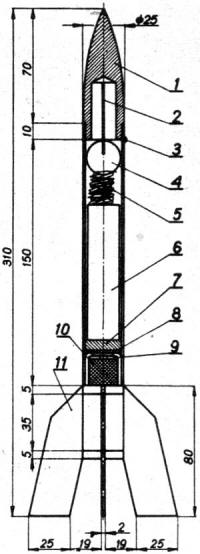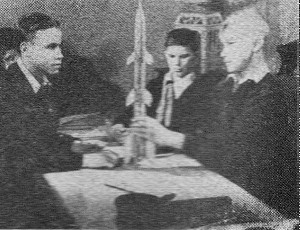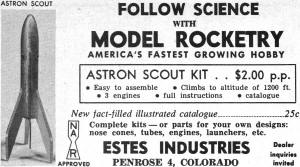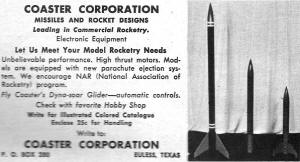|
Sometime around 1962, none other than Dr. Wernher von
Braun became a member of the National Association of Rocketry (NAR), as
reported in this edition of American Modeler. The Iron Curtain was still in place as the United States of American
and the Union of Soviet Socialist Republics battled it out for leadership in space. Model rocketry was involved in the contest
every much as the big boys who designed ICBMs and satellites. That "us versus them" attitude shone through often in the
"Rocket Trails" articles of the era. Oh. BTW, we won.
Rocket Trails - We Lead the U.S.S.R.
by Harry (Old Rocketeer) Stine
We Lead the Russians in M.R.; Data on Tuff Mice
|

Typical USSR model rocket: 1) nose cone; 2) antenna; 3) n.c. hinge; 4) payload; 5) shroud lines; 6) chute; 7) protective
wadding; 8) eject charge; 9) diaphragm; 10) engine; 11) fins.
|
Very little information about big-size rocketry comes out of the U.S.S.R. What I do get requires a lot of piecing together.
I know that Russia has a bunch of enormous rockets and that right now we can't come close to matching them in the orbital
weight-lifting contest. But I've found out that there is one area of rocketry where the U.S. has an honest four-year lead
over the Russkis!
Several months ago, your eagle-eyed Editor sent me a clipping from a Polish modeling magazine. It contained an article,
"Model rakiety ze Sputnikiem," by B. Dragunow. I could savvy the pictures and drawings, but the text looked like a type-setter
had gone mad. So I found an engineer who spoke Polish. He translated the text while I stood over him and supplied the English
equivalent of the rocketry terms.
It was all about a Russian model rocketry club in Krasnodarze (maybe you can find it on a map - I can't). Soviet rocket
engineer Eugene Buksz is supervising about twenty teenagers who build and fly model rockets. Their club is directly supported
by the State, because the Communists have discovered that this hobby helps train their future rocket engineers. Supposedly,
the Krasnodarze club is only one of several hundred in Russia.
Practically no information was given about the members of the club or how the club is operated. But the model rockets
they make were described in pretty good detail. They're about the same size as ours - a little over 12 inches long and about
an inch in diameter. Materials are paper and balsa. Fin stabilization. Parachute recovery systems. Replaceable rocket engines.
Models good for many flights. Staging possible.
But there the resemblance ends. In the U.S., we buy our model rocket engines. In Russia, Soviet modelers must still make
their own!
All dimensions, propellant mixtures, and loading procedures were given in the article. 12-gauge shotgun shells are used
for engine casings, and the propellant must be rammed and hammered in by hand, using tools described. With all this information,
I was able to make some rough calculations about performance of these little Russian go-bottles.
I'm convinced that we've got the U.S.S.R. hands-down in model rocketry. Their home-made engines develop about two pounds
of thrust for less than half a second, providing they've got a good propellant mixture and have been loaded right. I've
made similar engines in the old days before we could buy them, and I know this is a very tricky thing. About half of them
blow up ... which is why I don't recommend that you make your own.
In reliability, cost and performance, I'm sure that the Russian home-brewed engines can't compare with the Estes Type
A.8-4 or the MMI A-4 "Rock-A-Chutes," and that our Type B engines are even more superior. We don't run the risk of blowing
our heads off, either. If Russian teenagers make their own engines, America will eventually win the space race because there
are going to be lots of Russians without fingers or eyes.
The free enterprise system in America has made available 24 different types of engines, a growing selection of kits,
and catalogs full of parts and supplies. More are coming. In model rocketry, America not only leads Russia, but also the
world.
World Interest. At the National Association of Rocketry, letters arrive from allover the globe. People
in Guatemala, Japan, India, Argentina, and Italy want information about how we do it, where they can buy American equipment,
and whether or not they can use our NAR Model Rocket Sporting Code as a basis for their own rules. When I was in Washington
at the XII International Astronautical Congress, I talked with rocket people from Portugal, Iran, Germany, France, and Switzerland.
Model rocketry is starting in those countries.
With international activity increasing, we're going to need some worldwide rules pretty quick. The NAR is planning to
submit its sporting code to the Federation Aeronautique Internationale, with the help of the NAA, to serve as the basis
for these regulations. When and if this happens, we'll be able to compete internationally just as we now tangle in NAR national
contests every year.
This should be fun, and it will help our hobby. A lot of us would like to see how the British, the Italians, or the Brazilians
build and fly their models. The exchange of information that takes place at such contests would be worth its weight in solid
fuel.
|

Russian model rocketeers preparing "bird" for flight.
|
A lot of NAR rocketeers, myself included, are itching to compete with the Russians. We've got a 4-year head start on
them, and we intend to keep it that way. Maybe American model rocket enthusiasts can recapture some of that international
prestige that Major Titov took away from us.
International competition is coming. We've got to get the rules hammered out first. Then we can make smoke in the sky.
Report from the Pad. The NAR's new 1962 U. S. Model Rocket Sporting Code has been released. Most competition
events were modified to cut duplication. Model classifications and max frontal areas have been eliminated. Maximum weights,
engines and staging only are specified. There are several new events designed to keep competition abreast of progress -
boost-glider duration, for example. The USAF Aero-Space Systems Event is also new; it's such a gem of a competition. We'll
detail it in a subsequent column.
Speaking of boost-gliders, Vern Estes has a new kit on the market, the Astron Space Plane. This little jewel is a hot
number. Vern also has another kit, Astron Mark, now being shipped.
 Menford Sutton
of Coaster reports his concern's engines now have a delay train and ejection charge built into the units. NAR is testing
these. Menford Sutton
of Coaster reports his concern's engines now have a delay train and ejection charge built into the units. NAR is testing
these.
A gentleman named Dr. Wernher von Braun recently became a member of NAR.
Latest ignition trick involves # 30 nichrome wire. You can get a couple of miles of this at electric appliance repair
stores for next to nothing - it's used for heater elements. Take a 3-inch length, make three or four 1/16" diameter loops
in the middle, push loops up nozzle until in contact with propellant. Stuff little hunk of Kleenex in after to wedge the
wire in. Fires almost at once from four flashlight cells in series. Nichrome and Kleenex come out in short order once engine
ignites. Cheaper and more available than Jetex wick. Don't use with Coasters.
Everybody wants to fly a mouse. Be careful you don't lock horns with S.P.C.A. Don't use white lab mice; they are too
fragile because of inbreeding. Catch a field mouse; they are more rugged and last longer. Honestly, a mouse trap is an easier
way to get rid of these pests. Cheaper than a rocket, too.
Several still camera rockets have flown successfully, giving good photos. Movie cameras have been lofted by model rockets,
too. Paul Hans and Don Scott, both 15, of Port Washington, New York are sweating this one out: a processing lab lost the
50 feet of color film the boys retrieved by parachute.
 School
Club. Brett Norlem, science teacher in Lompoc, California, can't get the students to go home from school. He's
got a model rocket club going and has trouble with people wanting to stay and work all night on models. The grade average
in his science classes has soared like an Atlas. Engineers from nearby Pacific Missile Range also joining his group for
fun. Rocketman's holiday! School
Club. Brett Norlem, science teacher in Lompoc, California, can't get the students to go home from school. He's
got a model rocket club going and has trouble with people wanting to stay and work all night on models. The grade average
in his science classes has soared like an Atlas. Engineers from nearby Pacific Missile Range also joining his group for
fun. Rocketman's holiday!
National NAR Champ Doug Hylton, 15, of Colorado Springs recommends you build Coaster models like solid if you want them
to stay together in flight. Terrific acceleration rips off fins and sky fills with little pieces. Use Silkspan or gauze
reinforcement on fin joints.
Lots of stodgy old adults like yours truly are model rocket nuts, proving it isn't all teenage stuff. With so many adult
rocketeers the NAR has had to establish competition based on age. Guess too many oldsters complained that the kids were
outflying them. Only one national record is held by a Senior NAR member; ole "Red" Thompson took the payload record away
from me.
Some amateur gas-pipe rocket clubs are starting to swing to model rocketry. Reasons: cheaper, easier, and more room for
individual work.
Posted August 9, 2014
|





